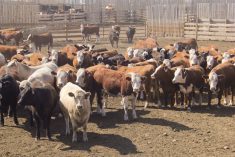Chicago | Reuters — U.S. soybean futures fell 1.5 per cent on Tuesday as Argentina’s decision to offer farmers a better exchange rate for their crops threatened to raise export competition at a time when U.S. offerings typically dominate the market.
“It just makes more product readily available short-term,” said Mark Schultz, chief analyst at Northstar Commodity.
Argentina’s farmers said on Monday the government’s decision to improve the exchange rate for soybeans exported in September is a temporary “patch” that will likely boost sales of the crop during the month, but fails to solve root issues.
Read Also

U.S. livestock: Feeder cattle hit contract highs on tight supply
Chicago | Reuters – All Chicago Mercantile Exchange feeder cattle futures and most live cattle futures hit contract highs on…
Corn futures were firm, gaining 1.5 per cent as concerns about harvest shortfalls across the U.S. Midwest underpinned prices. The strength in corn pulled wheat futures higher, which also benefited from signs of strong demand from overseas buyers.
Chicago Board of Trade soybeans posted a lower close for the fifth time in six sessions. Expectations for record U.S. production have acted as an anchor on prices as farmers prepare for harvest.
CBOT November soybeans were down 21-3/4 cents at $13.98-3/4 a bushel (all figures US$).
“A surge in Argentina producer soybean sales over the coming days could be negative for CBOT soybean futures, but we will have to see how producers react to the ‘soybean dollar’ in coming days,” said Terry Reilly, senior commodity analyst with Futures International in Chicago.
CBOT December corn was 10-1/4 cents higher at $6.76 a bushel and CBOT December soft red winter wheat gained six cents to $8.17 a bushel.
The market will get an update on field conditions from the U.S. Department of Agriculture crop progress report later on Tuesday. Analysts were expecting the report to show that good-to-excellent ratings for both corn and soybeans fell by one percentage point in the past week.
Favourable early projections for Brazil’s next soybean and corn crops were also capping U.S. prices.
— Reporting for Reuters by Mark Weinraub in Chicago; additional reporting by Gus Trompiz in Paris and Naveen Thukral in Singapore.
















